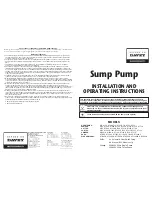
Installation, Operating and Maintenance Instruction
Model LSN
LSN 100-english
page 14
Revision 00
Article No 4264611
Issue
05/2003
Re-lubrication via the two grease nipples (636).
Bearing temperature (measured at bearing
bracket) should lie max. 50°C over ambient
temperature and must not exceed 90°C, control
weekly at least. On grease lubrication the bearing
temperature can temporarily be higher by 5-10°C
after regreasing, till a possible surplus of grease in
the bearings is cut.
6.6 Monitoring
In areas endangered to explosion it is
recommended to monitor the temperature of the
bearings and the vibrations of the bearing
bracket.
Regular monitoring and maintenance will extend
the life of your pump or pump system
.
Check oil level at least once a week and top up if
necessary.
Check pump for leaks at least once a week.
On packing, check quantity of leakage at least
once a week (see chapter 6.2 section "Packing").
Check the regulating and monitoring devices of
any sealing, flushing or cooling systems once a
week to ensure that they function properly.
Outgoing cooling water should be handwarm.
With double mechanical seals, monitor pressure
and flow rate in mechanical seal area; check at
least once a week.
Pumps which are exposed to corrosive chemicals
or to wear through abrasion must be inspected
periodically for corrosion or wear and tear. The
first inspection should be carried out after six
months. All further inspection intervals should be
determined on the basis of the state of the pump.
6.7 Shutting down
Close the valve in discharge pipe right before
(max. 30 seconds) switching off the motor. This is
not necessary if there is a spring-loaded check
valve.
Switch off motor (make sure it runs down quietly).
Close the valve on suction side.
Close auxiliary systems. Do not shut down cooling
system until pump has cooled down.
If there is any risk of freezing, empty pump,
cooling areas and pipes completely.
If the pump also remains under operating
conditions (pressure and temperature) when
stationary,leave all sealing, flushing and cooling
systems switched on.
The shaft sealing must remain sealed if there is a
risk of air being sucked in (in the event of supply
from vacuum systems or parallel operation with
shared suction pipe).
6.8 Storage / longer periods of non-
operation
6.8.1 Storage of new pumps
If the putting into operation shall happen a longer
period after the delivery, we recommend the following
measures for the storage of the pump:
Store pump at a dry place.
Rotate pump by hand at least once a month.
6.8.2 Measures for longer putting out of operation
Pump remains installed and in ready for operation:
Test runs of 5 min. duration must be made in
regular intervals. The span between the test runs
is depending on the plant. However, it should be
made once a week, at least.
6.8.3 Longer periods of non-operation
After long stationary periods, packings may
have hardened; these must be replaced before
start-up.
When starting up, follow the instructions for
starting up for the first time (see chapter 6)!
a) Filled pumps
Switch stand-by pumps on and immediately off
again once a week. Possibly use as main pump.
If the stand-by pump is at operating pressure and
temperature, leave all sealing, flushing and
cooling systems switched on.
Replace oil or grease after 2 years.
Stuffing box must be adjusted to maintain
lubrication of the packing (e.g. do not over
tighten).
b) Drained pumps
Turn shaft at least 1x week (do not switch on
because of dry running).
Replace oil or grease after 2 years.
7. Servicing, Maintenance
7.1 General remarks
Work should only be carried out on the pump or
pump unit when it is not in operation. You must
observe chapter 2.
Maintenance and servicing work must only be
carried out by trained, experienced staff who
are familiar with the contents of these Operating
Instructions, or by the Manufacturer's own
service staff.
7.2 Mechanical seals
Before opening the pump, it is essential that you
note chapter 2 and chapter 8.







































